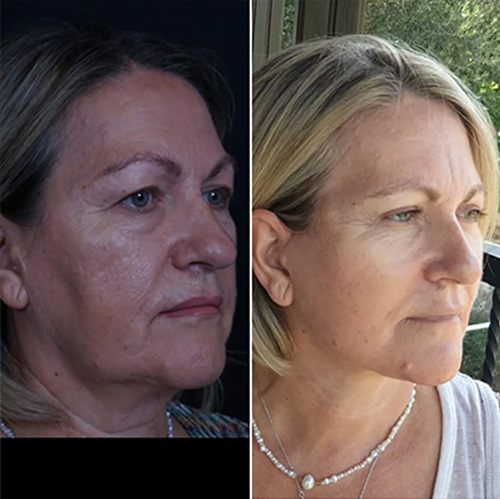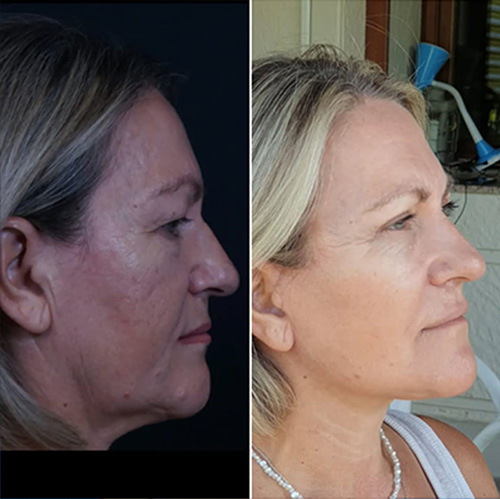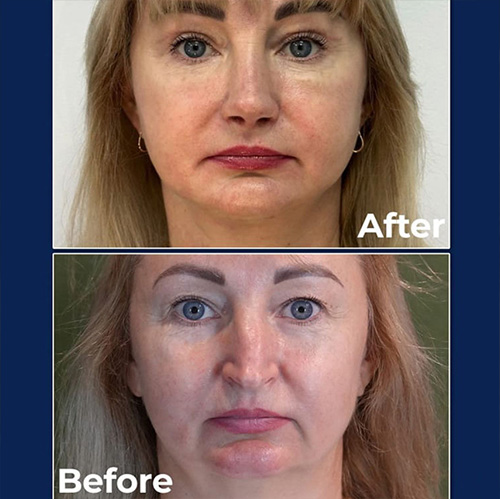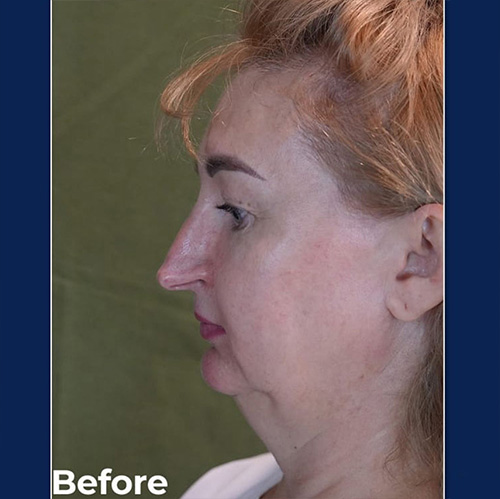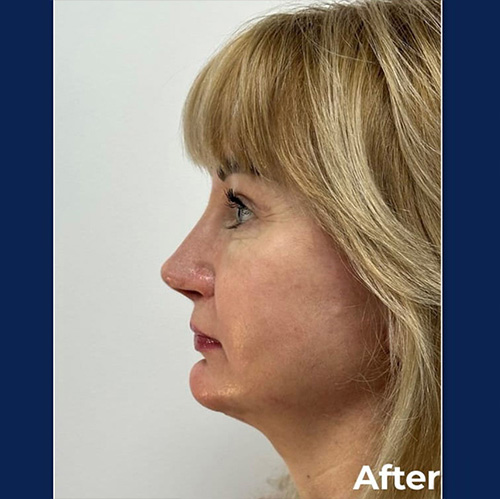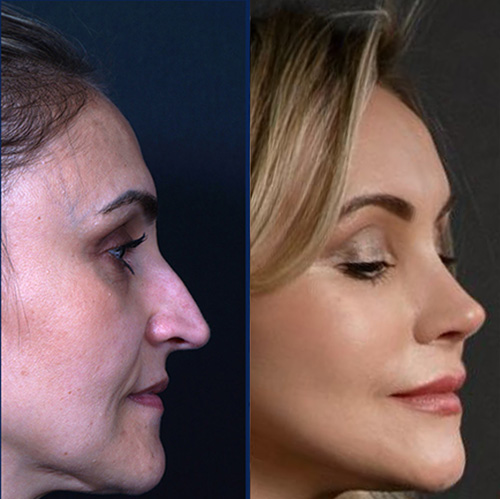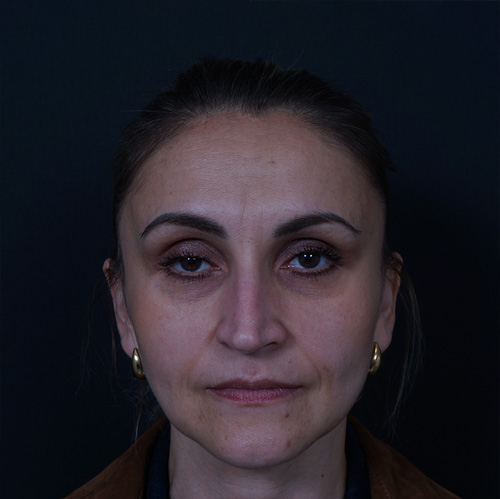Facelift

Deep Plane Facelift Surgery
The signs of aging on our face are revealed by structures that gradually shift downwards and begin to sag over time. This natural process is particularly noticeable on the jawline, cheeks, and neck. However, the most effective method to correct this sagging of facial structures and achieve a more youthful appearance is the deep plane facelift surgery.
Facelift Surgery and the Deep Plane Method
Facelift procedures can be performed using various methods. However, today, the deep plane facelift surgery stands out as the technique that provides the most lasting and effective results. A deep plane facelift allows for the proper upward lifting of both the facial muscles and connective tissues.
The main stages of the surgery are as follows:
1) Making the Incisions: The surgery begins with an incision placed within the natural creases in front of the ear. It extends from below the earlobe, behind the ear, and if necessary, along the hairline to the nape.
2) Lifting the Facial Skin: The facial skin is carefully lifted forward through the incision in front of the ear.
3) Targeting the SMAS Structure: The SMAS (Superficial Musculo-Aponeurotic System), located beneath the facial skin, is the connective tissue between the facial muscles and the skin. This layer is pulled upwards and sideways to achieve facial rejuvenation. Effectively lifting the SMAS is critical for obtaining a lasting result. This procedure is done while preserving the facial nerves.
4) Removing Excess Skin and Suturing: After the skin is lifted, the excess skin is carefully removed and sutured appropriately. To aid in wound healing, special external sutures (Surgical Net) are placed on the lifted area.
Anesthesia and Recovery Process
A deep plane facelift is usually performed under general anesthesia. Our patients stay in the hospital for two days after the surgery. This period is very important for the patient's comfort and to speed up the recovery process. The external sutures (Surgical Net) are removed three or four days after the surgery. The sutures in front of the ear are removed within five to seven days.
The recovery process is generally smooth. In a deep plane facelift, less skin is lifted, so there is less swelling. Most of our patients report that their faces look quite natural on the tenth day after surgery, and it's not obvious that they've had an operation.
Early Recovery and Flying
Post-surgery, some of our patients' recovery processes can be supported by recommending hyperbaric oxygen therapy. This treatment can accelerate the healing process and reduce swelling.
A facelift is generally known as a painless procedure. It only requires a short recovery period. You can travel by plane seven days after the surgery.
Who Are Suitable Candidates for a Facelift?
A facelift offers an effective solution for correcting sagging facial structures and a deteriorated jawline due to aging. However, it may not be a suitable solution for every individual. The most definite requirement for a facelift is when the cheek tissue has dropped below the border of the lower jawbone. Sagging in the cheeks and a loss of jawline definition cannot be corrected satisfactorily by other methods. This is a change that everyone experiences over time, but for some people, this problem can appear at an earlier age.
* Sagging in the Cheeks and Jawline: The most common complaint of candidates for a facelift is sagging in the cheek area and a loss of definition in the jawline. This sagging generally becomes more pronounced with age. However, in some people, the jawline may lose definition or the lower cheeks may become fuller at an earlier age.
* General Facial Drooping: Individuals who feel a general drooping in their facial area or who constantly pull their skin towards their ears in front of a mirror to tighten it can benefit from a facelift. This gesture can be a sign of the expected results from a facelift.
* Age Limit: There is no definite age limit for a facelift. However, some young individuals in their 20s are seen applying for a facelift. In this case, solutions are usually sought through simpler methods and different aesthetic procedures. After the age of 30, and especially from the 40s onwards, sagging in the cheek area becomes more prominent, and attempts to correct this with other methods may not yield satisfactory results. From these ages on, a facelift often provides a much more effective and permanent solution.
Risks for Facelift Surgery
Certain health conditions can be a contraindication for a facelift. These conditions can make the surgery risky:
* Bleeding and Clotting Disorders
* High Blood Pressure
* Uncontrolled Heart Conditions
* Heavy Smoking
Apart from these conditions, patients with a good general health status are ideal candidates for a facelift. If the patient's health is good, it is highly likely that satisfactory and natural results will be achieved after the surgery.
What Result Awaits You with a Facelift?
The primary goal of a facelift is not to completely change a person, but to restore the youthfulness lost over the years. With aging, the structure of our face changes over time, leading to sagging skin, volume loss, and a loss of jawline definition. A facelift is performed to correct these changes and achieve a younger, healthier appearance.
However, in some cases, a facelift is not limited to just correcting the signs of aging. Younger individuals, in particular, may opt for this surgery to alter their facial structure. For example, a facelift can be performed to lift lower facial volume, define an indistinct jawline, or make facial features more aesthetic. In this case, the goal is not to completely change the person, but to enhance the facial structure aesthetically.
The Permanence of a Facelift
The effect of a facelift is permanent. Initially, it can make you look 15-20 years younger. However, it is important to note that a facelift does not stop the aging process. That is, you will continue to age over time after the surgery. After the initial swelling and edema have subsided, about 6 months later, the facelift will have given you a rejuvenated appearance of about 10 years.
Additionally, the tissue formed as a result of the facelift process turns into a dense, collagen-rich tissue through a process called fibrosis. These tissues blend with healthy tissues and become stronger over time. Therefore, it can be said that the results obtained from a facelift can be maintained with less sagging over the years, meaning that aging will occur more slowly in the treated areas.
In Conclusion
A facelift offers an effective solution for correcting the effects of aging and achieving a natural rejuvenation. Our goal is not to change you, but simply to make you look younger. With structural changes to your face, you can achieve a more youthful and fresh appearance.

